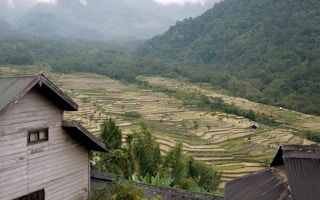“I’ve not hunted since 1998,” says Cayievi Zhünyü. Now in his late-70s, Zhünyü lives in Khonoma village, in the Indian state of Nagaland, near the Indo-Myanmar border.
In December 1998, hunting was banned in Khonoma’s forests after a 20-square-kilometre (8-square-mile) area was demarcated by the village council as the Khonoma Nature Conservation and Tragopan Sanctuary (KNCTS). For Zhünyü and other members of the Angami tribe that call Khonoma home, hunting was not a source of income — it was a sacred cultural practice.
“As the hunter, I can never eat what I’ve hunted,” Zhünyü says. “It’s bad luck. Instead, I feed my family and friends with it. Those occasions were some of the happiest moments of my life.” The hunting ban called for a huge shift in the lifestyle of the Khonoma people.
The inflection point came in the early-1990s, when villagers killed as many as 300 endangered Blyth’s tragopan (Tragopan blythii) in one week as part of a hunting competition.
For some conservation-minded village elders like Tsilie Sakhrie, this was alarming news. “Even with an airgun, the cheapest gun available, an expert marksman can kill nearly 300 to 400 [common] birds in one day. It would’ve been a very short while before our forests were devoid of any wildlife,” Sakhrie says.
Under the guidance of Thepfulhouvi Angami, then the principal chief conservator of forests in Nagaland, and community leader Niketu Iralu, Sakhrie began to campaign for the creation of a protected area within the 125-square-kilometre (48-square-mile) village, as well as a simultaneous ban on hunting and logging. But convincing the villagers wasn’t easy.
“First, we needed to sensitise the hunters,” says Khriekhoto Mor, another village elder who served as KNCTS chairman from 2014 to 2018. “Angami folklore, an important aspect of our tribe’s culture, is replete with stories of animals, birds and forests. So we had to get [the hunters] to understand that if the hunting continued, their children may never get to see these majestic creatures.”
“
The quickest way to achieve our conservation goals is to educate and involve our youth.
Tsilie Sakhrie, advisor, Khonoma Nature Conservation and Tragopan Sanctuary
Still, a mindset change this drastic required outside intervention. The village council invited experts from various conservation organisations in India to speak to Khonoma’s residents and conduct educational workshops. Sakhrie, Mor and their peers spent more than five years in dialogue with the villagers, which eventually led to the creation of the Khonoma sanctuary, the first ever community-led conservation project in India.
International recognition soon followed, when the sanctuary received a grant of US$5,000 from the Gerald Durrell Memorial Fund. “With the grant money, we were able to recruit the hunters to serve as forest wardens for a period of three years, and pay them a good salary,” says Mor.
For the cash-strapped, agriculture-dependent hunters of Khonoma, this regular income was a great incentive to turn from hunting to conservation. “When resistant villagers saw that even the most diehard hunters had accepted the new initiatives, any remaining opposition faded away.” Today, the sanctuary provides a safe haven not only for the Blyth’s tragopan, which is the state bird of Nagaland, but also for several other vulnerable species such as the leopard, the clouded leopard and the sloth bear.
Two decades of existence has not been without challenges for the sanctuary. In the early years, some young people pushed for lifting the hunting ban. Their persistent requests were met with a week of permitted hunting every year. However, in the past four years, there has been no easing of the hunting ban.
More recently, people from outside of the village have made occasional attempts at hunting and logging, which have been thwarted by the Khonoma Youth Organisation, responsible for monitoring the sanctuary. “The quickest way to achieve our conservation goals is to educate and involve our youth,” says Sakhrie, who now serves as the KNCTS advisor.
“To me, conservation is not limited to animals and birds. It extends to even the tiniest insect, invisible to the human eye,” Sakhrie says.
Sustainable agriculture
This all-encompassing attitude toward conservation is also reflected in the way Khonoma’s other natural resources have been managed over the centuries. The hillslopes surrounding the village are dense with Himalayan alder (Alnus Nepalensis), a tree capable of fixing atmospheric nitrogen into the soil.
“Our village ancestors noticed that farming on a site interspersed with these trees produced a much richer harvest compared to farming on a site with other tree species,” says Sakhrie. To this day, villagers still grow vegetables at the foot of alder trees.
To ensure the ability of this practice to continue, a site with alder trees is cleared of underbrush to grow vegetables for a couple of years and then left fallow for four to six years to allow the soil to rejuvenate.
This rotation of farming sites is crucial in preventing the destruction of new forestland for agriculture. “This understanding of the benefits of the alder tree has allowed Khonoma to stay self-sufficient since ancient times,” says Mor. The trees are never cut down; instead they are pollarded at a height of about 6 feet (2 meters), so that trimmed branches can be used as firewood or for making furniture. These practices have enabled some of the alder trees in the village to live well beyond 200 years. In 1998, the village council banned logging of all trees on community land.
Traditional wisdom also dictates that paddy terraces be positioned at the base of nearby hills, a practice that is followed to this day. Rice is planted in June to coincide with the start of the southwest monsoon. The fields are irrigated by rainwater that flows down the hillslopes, past alder trees, gathering nutrients. Because of this nutrient-rich water, farmers in Khonoma don’t need to use synthetic fertilisers.
India’s first green village
These age-old, sustainable agricultural practices along with the conservation success of Khonoma, drew the attention of the tourism ministry of the Indian government, which, in 2005, named the village India’s first “green village,” accompanied by a grant of 30 million rupees (equivalent to about US$700,000 in 2005 dollars), which was used to improve village infrastructure.
“Some tourists came to Khonoma even before the green village designation, due to its history of resisting British colonisation in the 1800s,” Sakhrie says. “But most visitors today are those interested in Khonoma’s biodiversity and its conservation success.” The village receives birdwatchers, journalists and researchers all year round, despite its fairly remote location. It has benefited greatly from the additional revenue generated by tourist entry fees, while several of the 600 households in the village earn income by providing homestay facilities, guides, taxis and other tourism-related services.
According to Sakhrie, people in other districts in Nagaland, in neighboring states such as Meghalaya, and as far away as Yunnan province in China have studied Khonoma’s efforts with interest in replicating those efforts in their own areas. Despite external threats of hunting and logging, the villagers are determined to protect the wildlife, forests and other natural resources with which their lives are so closely intertwined.
Special thanks to Visa Kuotsu for coordinating the interviews and for translating from English to Tenyidie (the Angami language) and vice versa, when required.
This story was written by freelance journalist Anne Pinto-Rodrigues and published with permission from Ensia.com.











